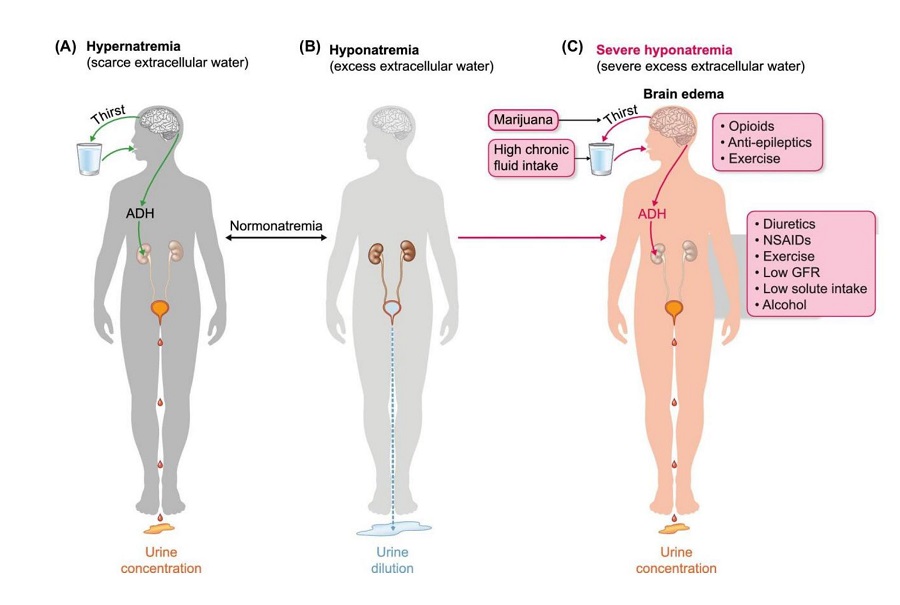Bruce Lee was an all-time influential martial artist. He died at 32 on 20 July 1973 in Hong Kong. His death was so mysterious that until now, the cause of Bruce Lee’s death is known. There are many hypotheses regarding his death, from hypersensitivity to Equagesic, the mafia assassination, a family curse, heatstroke, cocaine use, cannabis, and epilepsy.1,2
Hyponatremia as a possible explanation
According to the scientist, the actor’s cause of death might be hyponatremia, which results from the dilution of sodium due to too much water consumption. Due to the sodium imbalance, brain cell gets swell, leading to edema.1
Hyponatremia is an imbalance of sodium and total body water. This is the most common electrolyte disturbance, especially in older people.3 Serum sodium level will be less than 136 mmol/L is reported in hyponatremia, and it can be grouped into three different categories:
- Euvolemic hyponatremia
- Hypervolemic hyponatremia
- Hypovolemic hyponatremia3
The researcher investigates that Lee had a variety of risk factors for hyponatremia, such as a high fluid intake, use of marijuana, substances like prescription drug use, and alcohol intake that affect the kidney excretion system, and low solutes intake.
Water homeostasis2
The water balance in the body is controlled by plasma osmolarity. The elevation in plasma osmolarity, also called hypertonicity, is discerned by the hypothalamus osmoreceptors, which regulate both antidiuretic hormone (ADH) release and thirst.
Natremia is a serum sodium concentration in the blood, reflecting the water balance in the body. It is a vital contributor to serum osmolarity, and increases in concentration trigger the compensatory system, i.e., water ingestion, thirst, and vasopressin, leading to the excretion of lower volume with more concentrated urine.
Contrarily, excess body water will lessen the natremia and serum osmolality. It leads to the disappearance of thirst and ADH and, thus, increases water excretion in more dilute urine, which causes polyuria and restores homeostasis.
Another form of water elimination is through breathing, feces, and sweat. These forms of excretion are not regulated as most of the water elimination is conducted by kidneys. Patients with defects in urine concentration may reach the urine volume of 18-20 Lt/day. Henceforth, it is a surprise to see the development of hyponatremia conditions unless the water intake is higher than the rate of water excretion.
Severe hyponatremia is when water intake increases and water excretion decreases, which occurs after developing hyponatremia. Severe hyponatremia may trigger cerebral edema and herniation by the foramen magnum in the skull’s occipital bone. This whole situation leads to death within hours.

Figure: Water balance homeostasis and Bruce Lee’s risk factors for hyponatremia. Green arrows indicate adaptive mechanisms. Red arrows indicate that inappropriately activated mechanisms and not in line with the physiological needs to maintain water homeostasis.2
Conclusion
The scientist hypothesizes that the cause of death for Lee is a specific form of dysfunction in the kidney. The inefficacy of excreting ample water to maintain water homeostasis is mainly the tubular function. They added that this leads to hyponatremia which causes swelling in the brain and cerebral edema. In a few hours, edema leads to death when intake of excess water is not matched by water excretion in urine, which is seen in the case of Lee’s demise.1,2
Ironically, the famous quote by Lee is ‘Be water my friend’; however, excess water eventually killed him,” the researchers concluded.1
References
- Sharma A. Bruce Lee may have died from drinking too much water, claims study. NDTV. [Cited: 25 November 2022]. Available at: https://www.ndtv.com/world-news/martial-artist-bruce-lee-may-have-died-from-drinking-too-much-water-claims-study-3541506
- Villalvazo P, Fernandez-Prado R, Sánchez Niño MD. Who killed Bruce Lee? The hyponatremia hypothesis. Clin Kidney J 2022; 15: 2169-2176.
- Balbi A, Sadowski JA, Torrens D, et al. Hyperacute hyponatremia mimicking acute ischemic stroke. Am J Emerg Med 2022; 51: 428.e5-428.e7.

